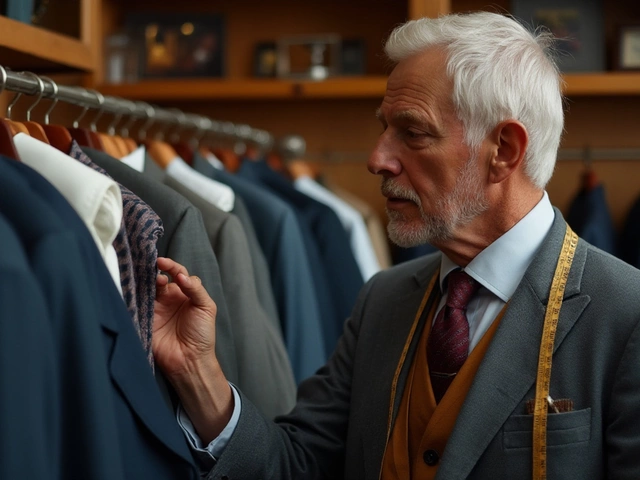What Is a Jacket With No Sleeves Called? The Real Names and Uses of Sleeveless Outerwear

- Cleo Fairchild
- 17 November 2025
- 0 Comments
Sleeveless Jacket Knowledge Quiz
How Well Do You Know Sleeveless Jackets?
Test your knowledge about bodywarmers, puffer vests, and sleeveless outerwear. Each question has one correct answer.
1. What is the most accurate term for a sleeveless, insulated outer layer designed to keep your torso warm?
2. Why are sleeveless jackets ideal for active use like hiking or cycling?
3. Which of these is a type of sleeveless jacket mentioned in the article?
4. What's the key feature that differentiates a true bodywarmer from a suit vest?
5. Which of these is NOT a common misconception about sleeveless jackets?
Your Score
Ever pulled on a sleeveless outer layer and wondered, what do you even call this thing? You’re not alone. It’s one of those clothing items everyone owns but no one seems to know the right name for. Is it a vest? A bodywarmer? A sleeveless jacket? The answer isn’t as simple as you think-and it depends on where you are, what it’s made of, and what you’re wearing it for.
It’s Not Just a Vest
The most common name you’ll hear is vest. But that word can be misleading. In the U.S., a vest usually means a sleeveless garment worn under a suit, like a waistcoat. In the UK, a vest is what Americans call a tank top. So when you’re talking about a sleeveless jacket-something meant to be worn over a shirt or hoodie for warmth-you need a more precise term.
The term that actually fits best in most cases is bodywarmer. It’s used widely in Europe and the UK for those quilted, padded, sleeveless layers designed to trap heat around your core. Brands like The North Face, Columbia, and Patagonia label their sleeveless outerwear as bodywarmers. They’re often made with synthetic insulation, have a zip front, and sometimes include a hood. This isn’t fashion fluff-it’s functional gear for cold mornings, hiking, or commuting.
Why Do People Wear Sleeveless Jackets?
You might think, Why not just wear a full jacket? But there’s a reason these things exist. Your arms generate a lot of heat, but they’re also the most active part of your body. When you’re walking, biking, or carrying groceries, full sleeves can get sweaty and restrict movement. A sleeveless jacket keeps your torso warm without overheating your arms.
It’s also great for layering. Throw a bodywarmer over a hoodie or flannel shirt, and you’ve got adjustable warmth. Take it off when you walk into a café, slip it back on when you step outside. No bulky sleeves to roll up or remove. That’s why you see them everywhere-from urban commuters to outdoor workers to college students on chilly campus walks.
Types of Sleeveless Jackets
Not all sleeveless outerwear is the same. Here are the main types you’ll run into:
- Quilted bodywarmers - The classic. Made with nylon outer shells and polyester or down insulation, stitched in diamond or square patterns. Often comes with a hood and zip pockets. Used for casual wear and light outdoor activity.
- Puffer vests - A subset of bodywarmers, but bulkier and puffier. Usually filled with down or high-loft synthetic fibers. Popular in colder climates. Brands like Canada Goose and Arc’teryx make premium versions.
- Technical shell vests - Made from windproof, water-resistant fabrics like Gore-Tex. No insulation. Designed to be worn over a thermal layer. Common in hiking and mountaineering.
- Fashion vests - Made from wool, tweed, or leather. No padding. Worn as a style statement over shirts or dresses. Think of a tweed waistcoat from a menswear brand or a faux-fur vest from a high-street label.
- Work vests - Often brightly colored, with multiple pockets and reflective strips. Used by road workers, delivery drivers, and security personnel. Built for visibility and durability, not warmth.
Each serves a different purpose. A quilted bodywarmer keeps you warm on a walk. A shell vest protects you from wind on a mountain trail. A leather vest? That’s purely for style.

When Did Sleeveless Jackets Become Popular?
Sleeveless outerwear isn’t new. The concept dates back to the 1800s, when hunters and laborers wore padded waistcoats to stay warm without restricting arm movement. But the modern version took off in the 1980s and 90s with the rise of outdoor recreation and technical fabrics.
The 1990s saw bodywarmers become a staple in streetwear. Brands like The North Face and Patagonia started marketing them as everyday gear, not just for climbers. By the 2010s, fashion designers like Alexander McQueen and Zara were putting their own spin on them-using bold colors, metallic finishes, and even fur trim.
Today, they’re everywhere. In 2024, sales of sleeveless outerwear in the U.S. and Europe grew by 22% year-over-year, according to market research firm Statista. Why? Because they’re practical, packable, and fit into a minimalist wardrobe.
What to Look for When Buying One
If you’re shopping for a sleeveless jacket, here’s what actually matters:
- Insulation type - Down is warmer and lighter but loses insulation when wet. Synthetic insulation (like PrimaLoft) works better in damp conditions and is cheaper.
- Shell fabric - Look for a wind-resistant outer layer. A 10K water resistance rating is enough for light rain or snow.
- Fit - It should fit snugly over your base layer but not be tight. If you plan to layer it over a thick hoodie, size up.
- Hood - Optional, but useful. A hooded bodywarmer doubles as a lightweight outer layer in unpredictable weather.
- Pockets - At least two hand pockets. Zippered ones are better for holding keys or phone.
Price range? You can find decent ones for $40-$60. Premium models with down insulation and weatherproofing run $120-$250. But for most people, a $50 quilted vest from Columbia or Decathlon will do the job.

Common Misconceptions
People mix up these terms all the time:
- “It’s just a vest.” - True, but only if you mean a bodywarmer. A suit vest isn’t the same thing.
- “They’re only for men.” - False. Women’s versions are just as common, often with a more tailored cut or added length.
- “They’re useless in winter.” - Not if you layer them right. Wear one over a thermal shirt and under a coat, and you’ll stay warmer than in a single heavy jacket.
The biggest mistake? Buying one that’s too loose. A bodywarmer that hangs off your frame won’t trap heat. It needs to fit close to your torso to work.
Alternatives to Sleeveless Jackets
If a bodywarmer doesn’t suit your style or needs, here are other options:
- Longline cardigans - Wool or cotton, no sleeves, longer than a vest. Great for casual wear.
- Shawl collars or capelets - More fashion-forward, less practical for cold weather.
- Thermal undershirts with zip fronts - These aren’t outerwear, but they’re the closest thing if you want core warmth without bulk.
None of these offer the same combination of warmth, portability, and layering flexibility as a proper sleeveless jacket.
Final Thoughts
If you’re looking for a lightweight, packable, and surprisingly warm layer that doesn’t restrict your arms, a sleeveless jacket-specifically a bodywarmer-is one of the smartest additions to your wardrobe. It’s not a trend. It’s a solution.
Next time you see someone wearing one, you’ll know exactly what it is. And if you’re shopping for one, you know what to look for: insulation type, fit, and a shell that blocks wind. Skip the cheap, flimsy ones. Get something that actually holds heat. You’ll wonder how you ever went without it.
What is a jacket with no sleeves called?
The most accurate term is bodywarmer, especially if it’s padded or insulated for warmth. In the U.S., people often call it a sleeveless jacket or puffer vest. In the UK, "vest" is common, but that can also mean a tank top, so context matters.
Is a vest the same as a sleeveless jacket?
Not always. A suit vest (waistcoat) is a formal, unlined garment worn under a blazer. A sleeveless jacket-like a bodywarmer-is insulated, often quilted, and designed to be worn as outerwear. They serve completely different purposes.
Are sleeveless jackets warm enough for winter?
Yes, if layered properly. Wear one over a thermal shirt or hoodie, and under a windproof shell or coat. The key is trapping heat around your core while allowing your arms to move freely. Many outdoor workers and hikers rely on them in sub-zero temperatures.
What’s the difference between a puffer vest and a bodywarmer?
A puffer vest is a type of bodywarmer. "Puffer" refers to the quilted, inflated look from high-loft insulation. "Bodywarmer" is the broader category that includes both puffer and non-puffer styles. All puffer vests are bodywarmers, but not all bodywarmers are puffers.
Can women wear sleeveless jackets?
Absolutely. Most brands make women’s versions with a more fitted cut, longer length, or added features like drawcords at the waist. They’re just as popular among women as men, especially for commuting, travel, and layering under coats.
Do sleeveless jackets work for active use?
Yes, they’re ideal for active use. Since they don’t restrict arm movement, they’re perfect for walking, cycling, hiking, or carrying bags. Many technical versions are made with stretch panels and moisture-wicking linings specifically for movement.


